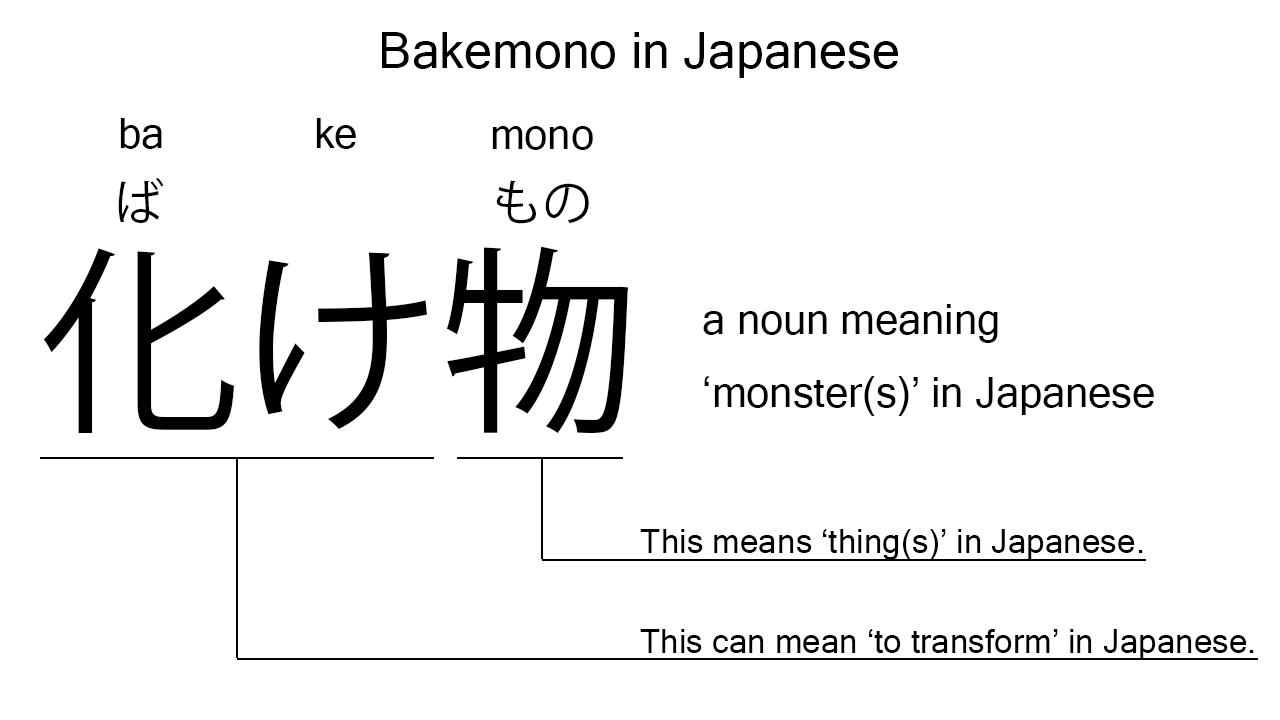What does “bakemono” mean in Japanese?
Native speakers say “bakemono” often to mean ‘monster’ in Japanese. Perhaps, some Japanese learners know this word as it is sometimes used in Japanese movies, novels, manga, anime, and the like. In this blog post, however, I will explain this word in detail based on its grammatical components. And also, I will explain how to use it through example sentences. My explanations would help Japanese learners understand “bakemono” more clearly. Then, let’s get started!
Contents
Definition and meanings of “bakemono”
Let me start with the definition and meanings of “bakemono”.
- bakemono – 化け物 (ばけもの) : a noun meaning ‘monster’ in Japanese. Depending on the context and situation, this can also mean ‘ghost’ or ‘specter’ in Japanese. This can also work as plural. Learn more about Japanese plural.
Japanese native speakers use this noun to refer to creatures which often look unfamiliar and terrifying. So, the usage is similar to those of the English nouns written above.
The definition and meanings are not that difficult, I think. To understand this noun more clearly, however, let me explain its grammatical components in detail, one by one.
What does “bakemono” literally mean in Japanese?
“Bakemono” consists of the following two components:
- bake – 化け (ばけ) : one conjugation of the verb, “bakeru”, which means ‘to transform’, ‘to shape-shift’, or ‘to metamorphose’ in Japanese.
- mono – 物 (もの) : a kanji character used to mean a thing, matter, or stuff. This can also be found in other words like “tabemono“, “nomimono“, “kaimono“, and “monogatari“.
From these two components, we can understand that “bakemono” literally means ‘transforming things’ in Japanese. This literal interpretation is not completely in line with the actual meanings, but still very close, I think. Monsters often transform their bodies.

When we meet new Japanese words, we should check their grammatical components in detail to understand their meanings clearly and deeply. In many cases, components tell us a lot about the meanings of the words they form. Actually, here, we could get the better understanding of “bakemono” through the detailed check above.
So far, I’ve explained the definition and meanings of “bakemono” together with its grammatical components. Then, let me explain how to use it through the example sentences below.
Example #1: how to say “monster” in Japanese
boku wa kinou koko de bakemono wo mi ta – 僕は昨日ここで化け物を見た (ぼくはきのうここでばけものをみた)
I saw a monster here yesterday.
Below are the new words used in the example sentence.
- boku – 僕 (ぼく) : a pronoun meaning ‘I’ in Japanese. This is used mainly by boys and young males.
- wa – は : a binding particle working as a case marker or topic marker. In the example, this works after “boku” to make the subject in the sentence.
- kinou – 昨日 (きのう) : a noun meaning ‘yesterday’ in Japanese. This can also work as an adverb almost anywhere in a sentence. In the example, this works as an adverb in the middle of the sentence to say “yesterday” in Japanese.
- koko – ここ : a pronoun used to refer to a place close to the speaker. In the example, this is used to mean ‘here’ in Japanese.
- de – で : a case particle used to say where someone does something. In the example, this is used after “koko” to say where the speaker saw “bakemono”.
- wo – を : a case particle used to make the object word in a sentence. In the example, this is used after “bakemono” to make the object in the sentence.
- mi – 見 (み) : one conjugation of the verb, “miru“, which means ‘to see’, ‘to watch’, or such in Japanese. In the example, it has been conjugated for the better connection with its following word.
- ta – た : an auxiliary verb used after a verb, adjective, or auxiliary verb to make its past tense form. Probably, this is well known as a part of Japanese ta form. In the example, this is used after “mi” to make its past tense form, “mi ta”.
This is a typical usage of “bakemono”. In this example, it works together with the case particle, “wo”, to become the object in the sentence. When we want to say “monster” in Japanese, this noun is always a very good option.
Example #2: another usage of “bakemono”
bakemono wa kotoba wo hanashi ta – 化け物は言葉を話した (ばけものはことばをはなした)
The monster spoke.
Below are the new words used in the example sentence.
- kotoba – 言葉 (ことば) : a noun meaning ‘language’ or such in Japanese. This can also work as plural.
- hanashi – 話し (はなし) : one conjugation of the verb, “hanasu“, which means ‘to speak’, ‘to talk’, or such in Japanese. In the example, it has been conjugated for the better connection with its following word.
This is another typical usage of “bakemono”. In this example, it works together with the binding particle, “wa”, to become the subject in the sentence. The original meaning of the Japanese sentence is more like ‘the monster spoke a human language’, but it has been translated as just ‘the monster spoke’.
Summary
In this blog post, I’ve explained the definition and meanings of “bakemono” in detail based on its grammatical components. And also, I’ve explained how to use it through the example sentences. Let me summarize them as follows.
- bakemono – 化け物 (ばけもの) : a noun meaning ‘monster’ in Japanese. Depending on the context and situation, this can also mean ‘ghost’ or ‘specter’ in Japanese. This can also work as plural. This noun literally means ‘transforming things’ in Japanese. This literal interpretation is not completely in line with the actual meanings, but still very close, I think. Monsters often transform their bodies.
Hope my explanations are understandable and helpful for Japanese learners.